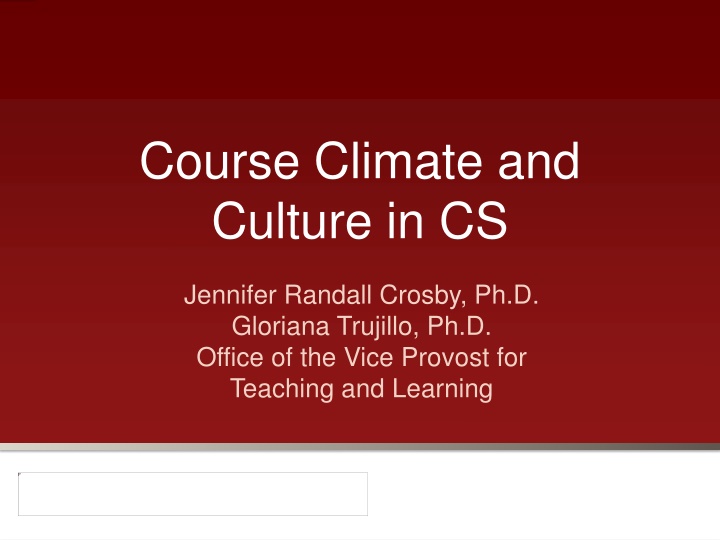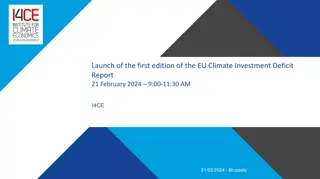
Microaggressions in Academic Environments
Explore the impact of microaggressions in academic settings, focusing on verbal and nonverbal slights that convey negative messages based on group membership. Learn how context and situation matter, with the power to create inclusive environments for student success in computer science. Uncover the implications of stereotype threat and gender differences in math. Addressing everyday challenges like stereotypes, biases, and unconscious behaviors can enhance diversity and foster a more inclusive culture in STEM fields.
Download Presentation

Please find below an Image/Link to download the presentation.
The content on the website is provided AS IS for your information and personal use only. It may not be sold, licensed, or shared on other websites without obtaining consent from the author. If you encounter any issues during the download, it is possible that the publisher has removed the file from their server.
You are allowed to download the files provided on this website for personal or commercial use, subject to the condition that they are used lawfully. All files are the property of their respective owners.
The content on the website is provided AS IS for your information and personal use only. It may not be sold, licensed, or shared on other websites without obtaining consent from the author.
E N D
Presentation Transcript
Course Climate and Culture in CS Jennifer Randall Crosby, Ph.D. Gloriana Trujillo, Ph.D. Office of the Vice Provost for Teaching and Learning @StanfordVTPL @stanfordonline online.stanford.edu vptl.stanford.edu
Whats happening? 80? 70? 60? Percent? Correct? 50? Solo? Female? 40? All? Female? 30? 20? 10? 0? Math? Verbal? Inzlicht & Ben-Zeev, 2000
Stereotype Threat Steele, 1997: Concern about being evaluated based on negative stereotypes about one s group Can affect any group for which strong, well- known, negative stereotypes are relevant in particular settings One does not need to believe in a negative stereotype for it to have an effect
Gender and Math 30? 25? 20? 15? Women? 10? Men? 5? 0? Gender? Differences? No? Gender? Differences? Spencer, Steele, & Quinn, 1995
What are the implications for CS? Context and situation matter (often more than we think they do) CA s have power to create environments that can increase the success of all students!
Uh, what did you say? You are so articulate! Where are you from? Yeah, but where are you really from? Oh, you re a CS grad student? I thought you were someone s girlfriend. You don t seem like a computer scientist. 6
Microaggressions Microaggressions are the everyday verbal, nonverbal, and environmental slights, or insults, whether intentional or unintentional, that communicate hostile, derogatory, or negative messages to target persons based on their group membership (Sue, 2010) 7
What do microaggressions look like? Can be verbal or nonverbal A women clutches her purse tighter when a Black man comes toward her A women of color being asked if she is lost in the Gates building A female graduate student being mistaken for a technician and administrator Often not intentional, but still hurtful 8
Creating a positive climate Starting the quarter / setting the tone Ground rules and agreements Humility and learning focus: If I say something wrong, let me know Create a mechanism for student concerns Acknowledge elephants in the room Master / slave model of communication 9
Creating a positive climate Learn student names and pronouns Show interest in students as individuals Model growth mindset Data from CS lab groups shows men are more likely to interrupt women be vigilant about interruptions and reinforce ground rules when needed 10
Addressing Stereotype Threat Help students attribute struggles to the difficulty of the work, not a lack of ability on their part Remind students of identities linked to academic success (Stanford students!) Expose students to positive, successful role models (could be you, could be examples or pictures you use)
Engage all students Eddy & Hogan, 2014: Increasing course structure through guided reading questions, preparatory homework, and in-class activities benefits all students, and especially Black and first generation students 21 Strategies
What questions do you have? Jennifer Randall Crosby, Ph.D. jrcrosby@stanford.edu Gloriana Trujillo, Ph.D. gloriana@stanford.edu 13
What will you do? Go to: http://tinyurl.com/CSCA-Survey Tell us one thing you will do as a CA to create and sustain an inclusive environment 14
Additional resources to learn more What I can do today to create a more inclusive community in CS No, I am not lost Experiences as a Black CS student Silicon Valley Sexism Setting Ground Rules for Multicultural Awareness Stanford Tutoring Stanford Academic Skills Coaching 15
Dig Deeper with Teaching Commons Building an Inclusive Classroom Supporting Vulnerable Students Teaching Science for All A Foundation for Understanding Gender Differences Four Skills to Emphasize for STEM Students STEM Classroom Scaffolds Seven Practices to Improve Retention of Women in STEM 16






















